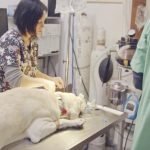Dr. Greenway discusses signs and treatment of arthritis in cats and dogs as well as four key factors to prevent any lameness or stiffness. Other topics covered in this video include the effects of weight gain and obesity, exercise, omega-3 fatty acids, antihistamines, diet trials, atopy, environmental allergens, contact allergies, allergy threshold, blood testing and allergy panels, shampoos, multifactorial, and working with your veterinarian to manage weight.
TRANSCRIPT:
I’m Dr. Clayton Greenway with healthcareforpets.com. I wanted to talk a little bit about arthritis. This is really common in our pets and particularly in our older, overweight pets and it’s largely overlooked. It can really impact their quality of life and I find that a lot of clients don’t really notice that arthritis is happening, they just kind of think my dog is getting older and it’s not moving around as well and it’s very common in cats and it’s rare for clients to really notice that arthritis is a problem.
The first thing I really want you to think about and this is very important is that any lameness whatsoever in your cat or dog means that they’re uncomfortable. It means that there’s inflammation in a joint and if there’s inflammation in a joint that joint is going to further breakdown. If those waves of inflammation are coming, you’re going to have something called degenerative joint disease and it’s going to get worse over time. So what’s really important is you manage these four key factors to prevent any sort of lameness or stiffness that your dog or cat is showing so that you don’t progress degenerative joint disease.
The first one is exercise, this is mostly related to our dogs. Dogs when we own them, we want them to run around. We think they should run around everywhere and as they get older you’ll still throw that ball so many times. I really want you to consider controlling their exercise, doing the level of exercise that’s appropriate so that they don’t come up lame or stiff the next day. For instance, my dad had a Border Collie, he lived down in the beaches and one day the dog just wouldn’t go up the steps anymore. So I asked him what he was doing and he would walk along the boardwalk but he would kick a ball probably 50 or 60 times and the dog would cover about 10 times the distance he would. So I told him kick it once or twice and then put the dog on a leash and walk the rest of the day. A day or two later, the dog was bounding up the steps again. So being aware that your dog is getting older and controlling its exercise is very important to prevent that flare-up, that inflammation of arthritis.
The second thing to make sure of is that your dog or cat is an ideal weight. I can’t stress enough that if they’re overweight, it’s really going to make them prone to arthritis. I really encourage you to take a look at our weight management tool and use it so that you get your pet to an ideal weight. By managing this, you’ll prevent arthritis. I’ve also seen some animals that have lameness and once their weight comes down it disappears, that they can manage it on that level of weight. Keep in mind as well, the heavier your cat or dog is, the higher the dose of medication they’re going to need to control that arthritis. It’s going to start to get very expensive, so make sure they’re a healthy weight and that will help prevent these problems as well.
The third thing to consider to prevent lameness, inflammation-related to arthritis is prescription medication. Now what a lot of vets will prescribe and I’ve done it many times is a non-steroidal anti-inflammatory, what we call it NSAID. This will have an immediate impact on inflammation in your dog and sometimes when a dog’s a little older and we just want to do a trial on it to see if it gives them a lot more comfort and mobility, I’ll sometimes do that over the short-term just to see if it really helps them. This will help manage the arthritis. What’s really important is that these drugs, they’re also a little bit costly but they’re a little hard on the body as well. They’ll have a number of side effects that you can ask your veterinarian about, so it’s really good to do some blood work before you start using medication like that.
The other thing is and this is less well used but I think is really effective is there are some other drugs you can use other than non-steroidal anti inflammatories that are cheaper and they’re healthier for your pet. There’s something called polysulfated glycosaminoglycans and what this does is it gets into the joint and it can decrease inflammation and they can have a series of injections and they can respond to those injections and not need any medication for months. These medications don’t work as immediately as the non-steroidal anti-inflammatories but they can be really effective at decreasing arthritis pain and inflammation overtime in your pet and they could be a lot more cost-effective and healthier.
The last thing to mention is the use of glucosamines. Glucosamines have been used for a long time in people and animals for decreasing arthritis pain and inflammation. Some dogs and cats will respond to them really well just like people and others won’t. We know anecdotally that they can really help and some people have found them to be really helpful. A lot of my clients have gone into health food stores and gotten a human glucosamine product and given that to their dogs. That sometimes works and I used to tell people to do that but then I once read a study that said the human products tend to have a lot more variability in each unit of glucosamine and that that doesn’t work very well for animals. This really frustrated me because I used to tell people to do that so I made the decision to start recommending the veterinary products and it was difficult for me because the veterinary products are much more expensive but I committed to doing that. Once I did that, people were coming back to me saying they definitely see a difference and I wasn’t seeing that as routinely with the human products so it turns out that study was pretty accurate. I think you can still do that if you’re looking at a cost effective way of giving them glucosamines but getting a veterinary product is something I really recommend. The other thing is glucosamines come in a couple different categories to consider. There’s all-natural products that have sources of glucosamine that naturally occur in nature and then there’s chemical products where it’s actually going to say the number of milligrams of glucosamine and then there’s a third product that has both of those. You want to look at these, I like to lean towards the natural products but every dog and cat is going to be different and they’ll respond to things differently so you can try these different products and see what works best in your pet.
So by managing these four things, again, it’s critical that you use these four things in combination to make sure that your pet does not have any inflammation in their joints, that they’re having no lameness and no recurrences of lameness because every time that happens, there’s inflammation of the joint and it further breaks it down.
So what I really want you to do is watch your pet carefully and make sure they’re not exhibiting some of these signs, be aware if they do. Don’t pass it off as your pet just getting older because they could be uncomfortable and some of these things I discuss can really alleviate that. In fact, there are some clients that have come to me and I’ve identified that their dogs have arthritis or their cats have arthritis and they really didn’t think so. Then when I started to medicate them they noticed a huge difference in their pet’s. They’d say things like “They have a new lease on life.” That makes me feel great when I’m able to do that but what it takes first is you identifying it, considering it, and going to your veterinarian.








